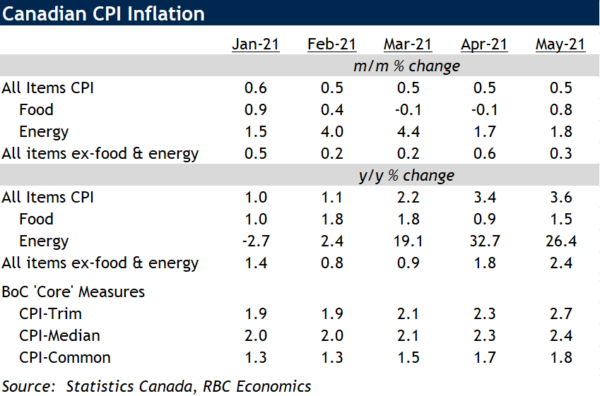- Headline CPI rose 3.6% year-over-year in May, 2.4% excluding food and energy components.
- Higher costs for homeowner replacement and passenger vehicles supported rise in core prices.
- Pent-up demand to take over as drivers of price growth.
Canada’s headline inflation rate rose 3.6% from a year ago in May, the highest in a decade. Energy prices were up 26.4% from exceptionally low year-ago levels and accounted for almost half of the increase, despite moderating slightly from April’s 32.7%. Growth for food prices rose 1.5% from already-strong levels last May, and will probably continue to grind higher on the back of elevated agriculture commodity prices.
Outside of food and energy, prices rose 2.4% from May 2020, faster than April’s 1.8% pace. Higher costs for homeowners’ replacement (+11.3%) and passenger vehicles (5%) again combined to account for a meaningful share of the gain, with the latter driven up by limited supply due to the global semi-conductor shortage. Prices for items like communications and clothing and footwear, although having increased in recent months, are still much lower than pre-pandemic levels.
Still, price growth has been increasingly broadly-based. 58% of goods and services in the consumer index basket were up 2% or more (on a 3-month rolling average basis) in May, up from 54% in April and well-above the 40% trough in September 2020. The Bank of Canada’s preferred ‘core’ measures all increased again in May. There have been some early signs of easing in some of the supply chain disruptions that sent industrial production input costs soaring. Raw lumber prices, for example, have moderated sharply in recent weeks (albeit to still elevated levels.) But consumer demand is set to surge as the economy reopens, and that demand, particularly for purchases of services, is expected to take over as a key driver of price growth in the second half of 2021.















